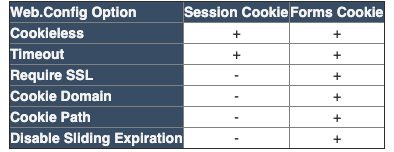Tags:
In Session Attacks and ASP.NET - Part 1, I introduced one type of attack against the session called Session Fixation as well as ASP.NET's session architecture and authentication architecture. In this post, I'll delve into a couple specific attack scenarios, cover risk reduction, and countermeasures.
Attack Scenario: ASP.NET Session with Forms Authentication
So understanding the decoupled nature of ASP.NET's session management from the authentication mechanisms outlined in the previous post, let's walk through two different session fixation attempts with Forms Authentication and session management.
Scenario 1: Attacker does not have a Forms Authentication Account
- Attacker browses target web site and fixates a session
- Attacker traps victim to use the fixated session
- Victim logs in using Forms Authentication and moves to areas of the site protected by forms authorization
- Attacker cannot pursue because he has not authenticated.
Not a big deal - UNLESS session reveals information or makes decisions outside of an authenticated area (within the same Application of course), which is very plausible. If the programmer happened to use Forms authentication and then strictly uses Session to make security decisions (no IPrincipal role authorization with Principal Permissions or authorization sections in the web.config), some real issues can result. Since session is decoupled from authentication, any area not controlled by authorization that shows session information can be exploited by the attacker.
Scenario 2: Attacker has their own Forms Authentication account
- Attacker browses to web site and fixates a session.
- Attacker Logs in to site using Forms Authentication.
- Attacker traps victim to use the fixated session.
- Victim logs in and moves to areas of the site protected by forms authorization.
- Attacker, still logged in under their own credentials, has the victim's session.
This was odd and even surprising to me at first when I actually pulled it off, but it works because Authentication is completely decoupled from the Session Management - they are tracked separately (different cookies, remember?).
Consider next that session fixation isn't the only problem - any session attack can take advantage of the decoupled nature of ASP.NET Session management and Authentication. If the attacker can fixate, hijack, or steal a Session from the victim, this type of attack will succeed no matter if the web site uses Forms Authentication, Windows Authentication, Client Certificates, etc. It doesn't matter. As long as the attacker also has an account in the system as well as the victim's Session ID, they can take over the session...that is unless the developer adds some additional checks - more on this later.
The take-away point is this - out of the box, authentication within ASP.NET does not provide protection from session attacks . This means that ASP.NET's session implementation is not concerned with the security of session as it relates to authentication. Session is a feature that developers can provide to any user, authenticated or not.
This means that developers must understand the implications of the asymmetrical relationship between session and authentication and protect against it or the ASP.NET sites will be vulnerable to various session attacks.
Countermeasures
The session infrastructure in ASP.NET is okay, but not as robust from a security perspective as it could (or should be, in my opinion). The ASP.NET session keyspace is decent - 120 bytes with good entropy, and a default 20 minute sliding window for expiration (30 minutes for Forms Authentication).
Comparing the configuration features APPLICABLE for securing the cookie for Forms Authentication vs Session - it's clear great care was taken to provide a broad range of options to protect the Forms Authentication Ticket cookie. The Session configuration options pale in comparison.

While not an "apples to apples" comparison (since session and authentication are different animals), the point I want to illustrate is this is the Cookie Protection features for both should be similarly strong.
Cookieless - should be avoided for both Forms Authentication and Session at all costs. It's just too easy to hijack a session with the ID in the URL unless you really aren't concerned so much with security.
Timeout - This timeout is typically a sliding value - so as long as the user is active on the site, the cookie remains valid (session OR authentication).
Require SSL - This requires that SSL be enabled for the Cookie to be transmitted. Forms authentication allows this, Session does not (though you can certainly do this programmatically which is a good idea if your site security should requires a higher level of protection).
Cookie Domain - This allows you to override the default domain on the cookie.
Cookie Path - This allows the cookie to be used for certain paths. This is important, as it can limit the area of the site where the cookie is valid. Forms Authentication allows this, Session does not, but perhaps could be set programmatically (not sure what the side effects would be, since ASP.NET may attempt to create a new cookie if the session object is used outside the set path). This could potentially help add protection to the session if this cookie path is to set to only authorized areas of the site.
Sliding Expiration - By setting this to false, Forms Authentication allows an absolute expiration of the cookie. For example, you can force expiration every 10 minutes, whether the user is active or not. With session, there's no way to force expiration.
While none of the above features are a slam-dunk 100% mitigation, they all certainly reduce risk. If ASP.NET was able to allow the Authentication Modules to collaborate with the Session module internally in certain situations through configuration, that would go a long way to add some protections in ASP.NET against session attacks.
So then the BEST solution, would be for ASP.NET to issue a NEW session ID after any successful authentication, and then transfer the session over to the new Session ID. That way if the attacker has a victim's session, once they log in, it will vaporize from the attackers perspective. Or better yet, NEVER deliver session until the user logs in. There's some code that looks like it may allow a new session ID to be distributed on login in KB899918 [4], but it's not presented in any useful or reusable way for the masses. The code is incredibly long and difficult to follow due to the nuances of setting cookies, allowing redirects, etc. The language of the KB article is also not very clear.
A way to mitigate (and even detect) this attack now for Forms Authentication or any other authentication mechanism, is to simply store something related to the Authentication in Session. Then on each subsequent request, make sure they match. This couples the authentication mechanism to session management - if they don't match - then a session attack occurred (or something's out of sync programmatically). So for Forms Authentication, you would store the Forms Authentication Ticket Name in Session. This value is stored in the forms cookie which is encrypted and persisted to the client after authentication and can be configured to be transmitted only over SSL/TLS.
Once you couple session and the authentication mechanism together and than configure Forms authentication properly, you can provide adequate session protection. Another important point - don't use Session anywhere outside of the authenticated areas of your site.
What Should Be Done?
As noted in Part 1, Microsoft closed a Bug submitted for this issue. To be fair, Microsoft has worked hard to improve the security of their code through the Security Development Lifecycle. To me, adding this feature in future versions of .NET is a no-brainer and right in step with their current security approach.
So back to the original question:
Should ASP.NET improve the session management module in ASP.NET to allow for more secure configuration by coupling it with Authentication mechanisms in ASP.NET?
I guess it depends on your perspective. The fundamental question is should Session be coupled to an authentication mechanism? This will depend on what the web site is doing and the level of acceptable risk, etc. If so, the session HTTP Module would need to be aware of the other Authentication HTTP Modules (which sort of breaks the pattern). Another option would be for each HTTP Module to implement its' own or share a common session manager...of course there are situations when you might want to use session without requiring authentication - should SSL, Path and Domain be configurable in the web.config for <sessionState>? Or should things remain as they are, and should those concerned with the issue just fix it in code as described above?
Should the onus be on the developer to know about this and mitigate it in code? Without having the feature in the framework and in the MSDN documentation, most developers will remain in the dark about these issue. Remember, we're still dealing heavily with SQL Injection and XSS issues in web sites...issues that we have known about how to protect against for years.
The INFOSEC community will almost always recommend you move a session after Authentication, meaning they have to be tied together (if the risk profile is such that you need that level of protection) - ASP.NET's is decoupled - there-in lies the issue...
Love to hear your thoughts as well!
References
Here's what a somewhat brief Google turned up for me on Session Fixation and ASP.NET - nothing quite seemed to address the issues described above:
- Threats and Countermeasures for Web Services - http://msdn.microsoft.com/en-us/library/cc949001.aspx
- MSDN Magazine March 2009 Security Briefs - Reveals the perspective from MS that the only attack is via cookieless Sessions (inaccurate): - http://msdn.microsoft.com/en-us/magazine/dd458793.aspx
- MS Employee Blog - Reveals assumption that cookie-less session is where the problems is (inaccurate) - http://blogs.msdn.com/paraga/archive/2005/12/10/502345.aspx
- How and Why SessionID's are reused in ASP.NET (.NET 1.1) - http://support.microsoft.com/kb/899918
- JoelOnSoftware Forum Discussion on Session Fixation - http://discuss.joelonsoftware.com/default.asp?dotnet.12.484800.5



